Keywords
|
| Latent, Rolled, Finger print, Descriptor Hough transform, additive Noise, Noise reduction |
INTRODUCTION
|
| A biometric is any unique biological characteristic that can be used to person identification. The name "Bio" refers to the an account of the series of events making up a person's life physiologically that are measured, while "metrics" refers to the system of measurement related to the quantitative analysis that provides a positive identification of a unique individual. While in registration process, physical and behavioral samples are captured by either fingerprint scanner or video camera. Authentication of biometric requires comparing registered biometric sample against a newly captured biometric sample. Generally the process consists of four-step process: Capture, extraction, Comparison, Match/non-match followed by a Verification and identification. In the 21st century, it seems almost intuitive to think of our bodies as natural identification systems for our unique selves. Biometrics involves using the different parts of the body, such as the fingerprint or the eye, as a password or form of identification. Presently, Federal Bureau of Investigation uses the fingerprints from a crime scene to find a criminal. A fingerprint is the pattern of ridges and valleys on the finger tip. The curving of pattern line structures called ridges, where the skin has a higher profile than its surroundings, which are called the valleys. Fingerprint is thus defined by the uniqueness of the local ridge characteristics and their relationships. To ensure that the performance of the minutiae extraction algorithmic feature will be robust with respect to the quality of fingerprint images, an enhancement algorithm which can improve the clarity of the ridge structures is necessary. Poor quality prints feature extraction is the most challenging problem faced in this area. Enhancements methods exist are studied to enhance the quality of the fingerprint images. Mostly the minutiae sent to the final matching phase are extracted from the Skelton images. The minutiae extraction accuracy depends on the quality of the Skelton image. Reference point and image alignment are both determined to estimate the orientation point and that effect is smoothen by chosen window in order to minimize the effects of noise and matching with a similarity measure. Matching is performed by comparing two fingerprint images and return either a degree of similarity or a binary decision of matched or not matched. Most fingerprint matching system is based on matching minutiae points between two fingerprint images. Fingerprint matching is the key to the system and effects on the precision and efficiency of the whole system directly. |
RELATED WORK
|
| Fingerprints have been used by humans for personal identification for a very long time [1]. Fingerprint matching latest techniques were initiated in the late 16th century [2]. Important time line event that has established the foundation of modern fingerprint based biometric technology found in. The uniqueness and individuality of fingerprints is discovered by Henry Fauld, in 1880 and the credit for being the first person to study the persistence of friction ridge skin goes to Sir illiam James Herschel [1]. This enhancement established the foundation of modern fingerprint identification. In the late 19 century, Sir Francis Galton has published the book called fingerprints [3] in which detailed fingerprint analysis and identification is discussed. The minutiae features introduced by him for single fingerprint classification in 1888. The uniqueness discovery of fingerprints caused an immediate decline in the prevalent use of anthropometric methods of identification and led to the adoption of fingerprints as a more efficient method of identification. The most advance in fingerprint identification was made in 1899 by Edward Henry, who (actually his two assistants from India) established the famous “Henry system” of fingerprint classification [4] an elaborate method of indexing fingerprints very much tuned to facilitating the human experts performing (manual)fingerprint identification. In the early 20 century, fingerprint identification was formally accepted as a valid personal identification method by law enforcement agencies and became a standard procedure in forensics. Identification of fingerprint agencies were setup worldwide and criminal fingerprint databases were established. The fundamental problem in image processing is to remove the additive white Gaussian noise (AWGN) without blurring the fine details of the images. so enhancement algorithm which will improve the clarity of the ridge/valley structures. Based on the survey related to fingerprint enhancement, it had been observed that most of the existing works are based on the minutiae sets, singular points and other techniques. |
PROPOSED LATENT FINGER PRINT APPROACH
|
| There are three main steps in fingerprint matching: alignment (or registration) of the fingerprints, pairing of the minutiae, and score computation. In our approach, we use a Descriptor-based Hough Transform to align two fingerprints. Given two sets of aligned minutiae, two minutiae are considered as a matched pair if their Euclidean distance and direction difference are less than pre-specified thresholds |
| Finally, a score is computed based on a variety of factors such as the number of matched minutiae and the similarity between the descriptors of the matched minutiae pairs. Figure 1 shows an overview of the proposed approach. It is important to emphasize that while latent’s are manually encoded (namely marking minutiae), minutiae in rolled prints are automatically extracted. |
LOCAL MINUTIA DESCRIPTOR
|
| Minutia Cylinder-Code (MCC) is a minutiae representation based on 3D data structures [1]. In the MCC representation, a local structure is associated to each minutia. This local structure is represented as a cylinder, which contains information about the relationship between a minutia and its neighboring minutiae. The base of the cylinder is related to the spatial relationship, and its height is related to the directional relationship. Each cell in the cylinder accumulates contributions from each minutia in the neighborhood. The resulting cylinder can be viewed as a vector, and therefore the similarity between two minutia descriptors can be easily computed as a vector correlation measure. A more detailed description of the cylinder generation and of the similarity between two cylinders can be found in [1]. This representation presents some advantages, such as: invariant to translation and rotation; robust against small skin distortion and missing or spurious minutiae; and of fixed length. |
FINGERPRINT ALIGNMENT
|
| Fingerprint alignment or registration consists of estimating the parameters (rotation, translation and scale) that align two fingerprints. There are a number of features that maybe used to estimate alignment parameters between two fingerprints, including orientation field, ridges and minutiae. There are also a number of ways of aligning two fingerprints: Generalized Hough Transform, local descriptors, energy minimization, etc. |
MINUTIAE PAIRING
|
After aligning two sets of minutiae, we need to find the minutiae correspondences between the two sets, i.e. minutiae need to be paired. The pairing of minutiae consists of finding minutiae that are sufficiently close in terms of location and direction. Let  be a minutia from the aligned latent and be a minutia from the aligned latent and  be a minutia from the rolled print. Then, be a minutia from the rolled print. Then,  are considered paired or matched minutiae if are considered paired or matched minutiae if |
 |
 |
| In aligning two sets of minutiae, this is the most natural way of pairing minutiae. We use a one-to-one matching, which means each minutia in the latent can be matched to only one minutia in the rolled print. Ties are broken based on the closest minutia. |
SCORE COMPUTATION
|
| Score computation is a very important step in the matching process. A straightforward approach to compute the matching score consists of the number of matched minutiae divided by the average number of minutiae in the two fingerprints. This is not appropriate for latent matching because the number of minutiae in different latents varies substantially. One solution to modify the above scoring method is to divide the number of matched minutiae by the number of minutiae in the latent, which is almost always smaller than the number of minutiae in the rolled print. In our approach, we use minutiae similarity to weight the contribution of each pair of matched minutiae. Given a search fingerprint (latent) and a template fingerprint (rolled), and considering that the fingerprints are already aligned, let M be the set of n matched minutiae pairs between the two fingerprints, {mi}n i=1 be matched minutiae pairs in M, {Si}n i=1 be their respective similarities, and N be the number of minutiae in the latent. Then, the matching score between the two aligned fingerprints is given by: |
 |
| To further improve the matching performance, we combine the scores based on matched minutiae from two different pairing thresholds by their weighted sum; we assume equal weights. Since we perform 10 different alignments, we compute 10 different matching scores between two fingerprints; the final score between the two fingerprints is the maximum among the 10 scores computed from different hypothesized alignments. |
EXPERIMENTAL RESULTS
|
| Matching experiments were conducted on two different latent fingerprint databases: NIST Special Database 27 (NIST SD27) and West Virginia University Latent Fingerprint Database (WVU LFD). 1) NIST Special Database 27 (NIST SD27): NIST Special Database 27 is the only publicly available database comprising latent fingerprints from operational scenarios (latents collected at crime scenes). It consists of 100 latent fingerprint images and 100 corresponding (mated) rolled prints. Both latents and rolled prints are available at 500 ppi. The quality of the latents in NIST SD27 varies, reflecting the operational (casework) quality. Figure 4 shows latent print matching under Noises less condition original one identified at rank-1, and Fig. 5 shows latent print matching under Noisy with noise reduction condition original one identified at rank-1. |
| These two latents were matched to their true mates at ranks 1253 and 1057, respectively. |
CONCLUSION AND FUTURE WORK
|
| We have presented a fingerprint matching algorithm under Noise, Noise less and by noise reduction designed for matching latents to rolled/plain fingerprints. Our algorithm outperforms the commercial matcher VeriFinger over all qualities of latents in FCV 2002 Database. The improvement in the rank-1 accuracy of the proposed algorithm over VeriFinger varies from 2.3% for latents with relatively large number of minutiae to as high as 22% for latents with the subjective quality “ugly”. These results show that our matcher is more suitable for latent fingerprints. The proposed alignment method performs very well even on latents that contain small number of minutiae. In our algorithm we take the maximum score from several hypothesized alignments based on different alignment parameters. Sometimes, the maximum score does not correspond to the correct alignment. We plan to improve the score computation by applying learning methods. Extended features manually marked by latent examiners have been shown to be beneficial for improving latent matching accuracy. We plan to incorporate extended features which are automatically extracted from the image into the current matcher to further improve the matching accuracy. |
| |
Tables at a glance
|
 |
| Table 1 |
|
| |
Figures at a glance
|
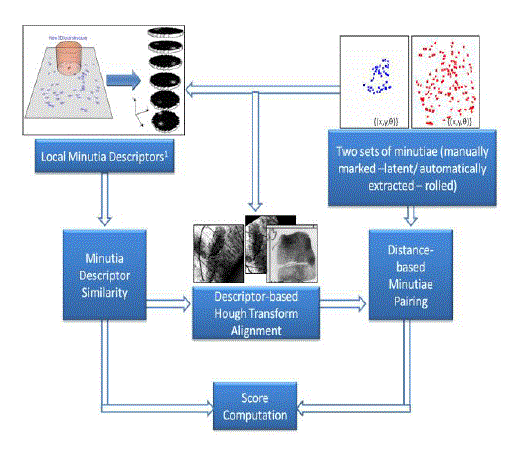 |
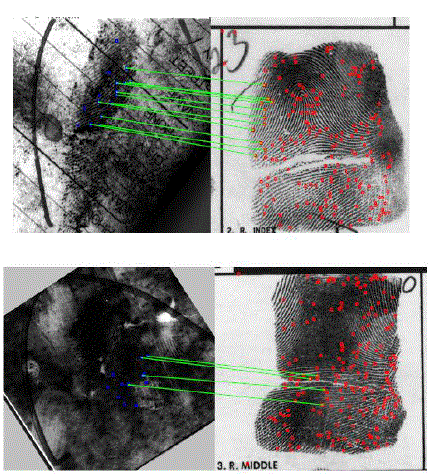 |
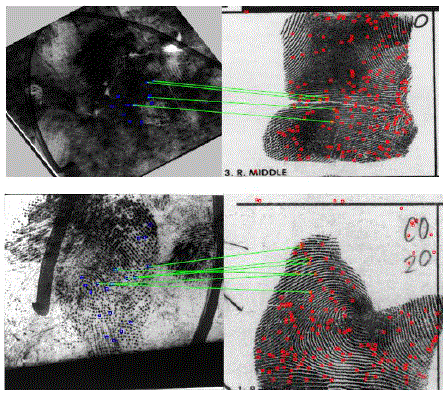 |
| Figure 1 |
Figure 2 |
Figure 3 |
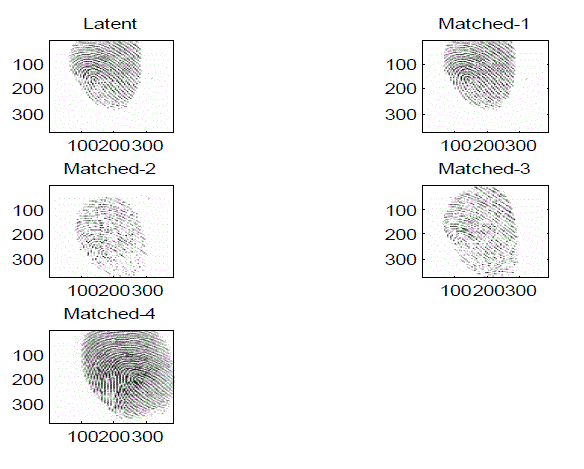 |
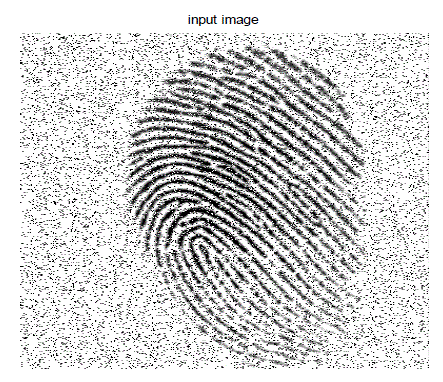 |
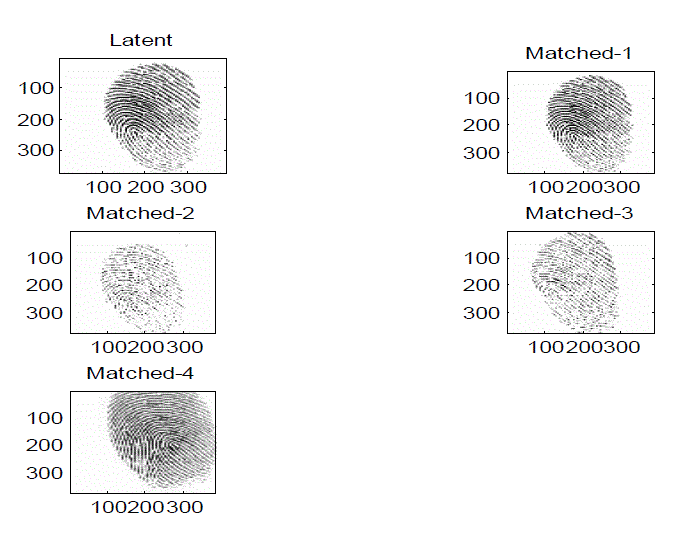 |
| Figure 4 |
Figure 5 |
Figure 6 |
|
| |
References
|
- Paulino, A.A. ; Dept. of Comput. Sci. & Eng., Michigan State Univ., East Lansing, MI, USA ; Jianjiang Feng ; Jain, A.K, Information Forensics and Security Latent Fingerprint Matching Using Descriptor-Based Hough Transform, IEEE Transactions on (Volume:8 , Issue: 1 ) Biometrics Compendium, IEEE Jan. 2013.
- H. Cummins and C. Midlo. Finger Prints, Palms and Soles: An Introduction to Dermatoglyphics. Dover Publications, Inc., 1961
- H. Faulds. On the skin-furrows of the hand. Nature, XXII:605, October 1880
- J. Feng, S. Yoon, and A. K. Jain. Latent fingerprint matching: Fusion of rolled and plain fingerprints. In International Conference on Biometrics (ICB), June 2009
- W. Herschel. Skin furrows of the hand. Nature, page 76, November 25th 1880
- K. Jain and J. Feng.Latent fingerprint matching. IEEE Trans. PAMI, 33(1):88–100, January 2011
- K. Jain, J. Feng, A. Nagar, and K. Nandakumar. On matching latent fingerprints. In CVPR Workshops on Biometrics, pages 1–8, June 2008.
- D. Maltoni, D. Maio, A. K. Jain, and S. Prabhakar. Handbook of Fingerprint Recognition. Springer Verlag, 2nd edition, 2009
- Neurotechnology Inc. Verifinger. http://www.neurotechnology.com/verifinger.html. 4
|